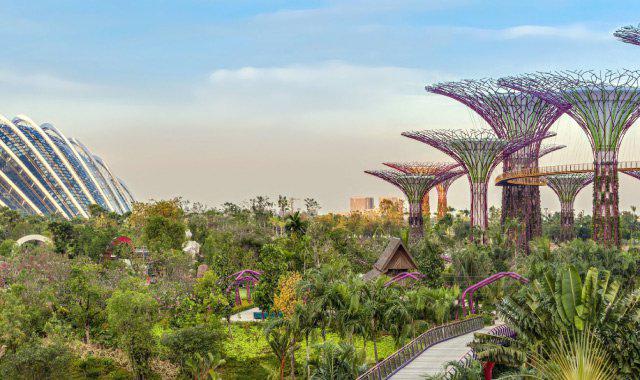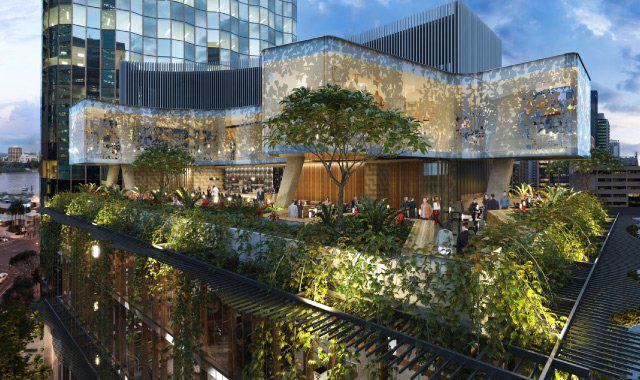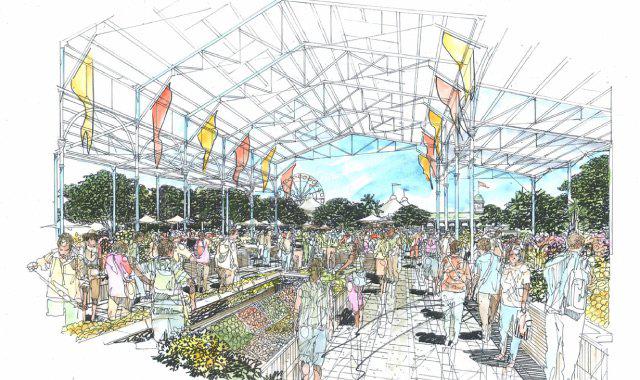Brisbane City Centre Masterplan - Photo Courtesy of Urbis
Strong urban design offers significant community benefits, better quality of life, safer and more secure cities and a greater ability to function as a society. It also provides each city with a unique sense of identity and establishes the framework for it to be more responsive to differing climatic, economic or social variables. Regardless of the size of a city or project, urban design is inclusive in achieving outcomes that holistically make for better built environments and in turn way of living.
In a recent interview with Urbis National Director James Tuma, The Urban Developer investigated a series of urban design strategies that are key to achieving better cities . These are strategies that transcend the specific differences between each city and are an overarching guide to what makes for enhanced quality of urban life. A guide to more valuable, contemplated and viable cities that is useful to both those shaping and utilizing them.
Clarity of Purpose and Position is Key
The ability for a city to positively evolve relies solely on the effectiveness of the plan behind it. If that plan is unclear or disjointed the urbanization will follow suit. If established correctly all parties involved in shaping a city can consolidate easier and efficiently achieve one clear vision.
“The best urban outcomes start with a clear idea about purpose, a personality for the place if you will. Knowing what it is you are seeking to become brings order and clarity to design thinking and creates a clear framework around which investment can be prioritised and staged.” Says Tuma.
Singapore’s singular vision of ‘city in a garden’ is a clear example of clear purpose and key positioning. An example of urban design managed particularly successfully due mostly to the Singaporean style of governance. The implementation of this action plan has had a direct effect on the design, character and delivery of every part of the city.
In order to convert Singapore from a ‘garden city’ to a ‘city in a garden’ the government proposed the following urban strategies;
Establish world-class gardens
Rejuvenate urban parks and enliven streetscapes
Optimise urban spaces for greenery and recreation
Enrich biodiversity in urban environment
Enhance competencies of the landscape and horticultural industry
Engage and inspire communities to co-create a greener Singapore
With the key elements towards success being;
Good Governance
Good Planning/ Vision
Innovation
Whole Of Government - Strong Leadership, Effective Implementation, Pragmatism
Co-Creation (Gov With People)
By 2030 the Singapore Government hope to achieve through this plan of action;
85% of Singaporeans will live within 10-15 minutes’ walk of a park
8 in 10 homes within a 10 minute walk of a Mass Rapid Transit (MRT) station
900ha of reservoirs and 100km of waterways opened up
Park Connectors extend from 200km to 360km
Improve recycling rate from 59% (2011) to 70%
Reduce total domestic water consumption from 153 litres (current) to 140 litres per capita per day
Increase greenery in high-rise buildings to 50ha
70% of journeys to be made by public transport

Gardens by the Bay features 'supertrees' that loom up to 50 metres tall, providing shade in the daytime and an illuminated spectacle at night. Photo courtesy of Gardens by the BayBe Flexible and Accept Change will happen
Having an overarching plan towards the identity of a city is important however equally so is ensuring it's flexible enough to accommodate variable factors.
“The era of the noble blueprint for precincts and places has passed. That is not to say a compelling image of the future state of a development isn’t important (it is) – but rather that the strategies and principles behind this is where the real value lies. Changes in market conditions, access to capital, retail trends and other factors all require constant tuning and flexibility built around a strong set of ideas that ensure whatever the outcome, it has a sense of coherence and, as noted, purpose.”
Flexibility within structure is exemplified through Brisbane’s ‘new world city’ plan. In particular the ‘buildings that breathe’ design guide which provides a series of strong strategies that can be applied in varying ways to respond to prevailing market conditions; whilst at the same time working toward the intent of a truly subtropical city form. These are a set of guidelines that are rigid enough to achieve consistency across the city yet still remain flexible for the unforeseeable. The parameters within this guideline are;
Orientate yourself
Occupy outdoor spaces
Illuminate with daylight
Natural air and ventilation
Shade and protect
Living greenery
Identity matters
Reduce energy and waste

20 Creek Street, Brisbane. An example of a development designed within these guidelines - Photo courtesy of BVN Architects
Mean Something to Someone (not nothing to everyone) In the context
By creating a strong sense of place it increases the likelihood of positive interaction and engagement. Precincts and places being considered as part of a wider ecosystem of destinations and being distinctive is critical to long term attractiveness and short term performance.
“This may mean a strong local food theme like the Grounds of Alexandria or an arts DNA like the art series hotel chain. Other opportunities include the integration or wellness, environmental, sport, local crafts or culture – the list of points of differentiation is endless but having one is essential in creating high performance urban design and places that mean something to someone.”
By staying true to showing its heritage and maintaining its character, the RNA precinct in Brisbane is being allowed to evolve yet still remain meaningful. This will determine its long term success as a precinct because it's primary function is events and attractiveness to the community is pivotal.
A key strategy in achieving this is the master-plan upgrading around a long existing and celebrated event. Instead of relocating the annual Royal Queensland Show (Ekka) and completely repurposing the area, the precinct is being built up to improve a current function that has strong ties to the community. To relocate the Ekka would have removed historic meaning from the precinct.

RNA Precinct Artistic Impression - Photo courtesy of Shane Thompson Architects
Start with Context and Connectivity
Never design just the site. Successful developments integrate with their context as opposed to standing alone. How society functions around the site is equally as important as how they do within it.
“The days of red lines around precincts are long gone as we understand much better that it's the agglomeration of destinations and experiences that draw out and capture real value. In this context investment in seamless linkages tends to add more value than the idea of ‘gateways’ – it means the project is about making the city better rather than making an isolated precinct.”
Context and connectivity are major factors in Sydney’s Goods Line. Connecting more than 80,000 tertiary students it’s surrounded by some of Sydney’s most important cultural, educational and media institutions. The Goods Line is increasing engagement using a series of public attractions such as grassed areas, dining spaces, study pods in the trees and table tennis tables. In addition it’s also recently fostered a culture for pop-up events. By acting as a connective tissue across multiple sites and precincts The Goods Line is elevating value and amenity between a series of prominent destinations.
The Public Realm is the Plan
French philosopher Roland Barthes said once that "The skyscraper establishes the block, the block creates the street, the street offers itself to man." In order to achieve successful cities ‘public realm’ is imperative.
A notion strongly supported by Tuma. “People visit, and choose to stay and invest in a place, primarily because of the experiences they have in the public realm. Streets and spaces are the backbone of these positive experiences and the most successful developers know this. Recent work in transforming the streets of New York into pedestrian friendly spaces, and in London where strategic cycling and pedestrian infrastructure has transformed major traffic routes, are examples of this and have had marked effects on the perceived liveability and attractiveness of those cities.”
Another example is Kings Cross London where a clear structure for the public realm has driven in turn the land use and events activation strategy. Kings Cross was a unique opportunity to develop the largest plot of derelict and underused land in Central London. A development that solely focused around improving the public realm and therefore improving the value of the area. Objectives for doing this were as follows;
good streets, parks and places where people can meet;
they mean good schools, shops, jobs and services;
they are safe, well managed and maintained;
they include affordable and market housing;
they are well connected by public transport; in short
they are places where people are proud to live.
(John Prescott, Prince’s Foundation “Traditional Urbanism” Conference, November 2003).
Balance Systems and Empathy
The best urban design prioritises people (experiences, clarity, purpose, adventure) and uses systems to quietly support these.
“Experiences are the new capital of urban design (and where commercial value truly lies) however there is often confusion around how to make places worth experiencing. The smart city agenda is an example (one of several) where the natural attractiveness of innovation and performance as part of the place is seen to be cutting edge’ and therefore critical to success. However, technology is an enabler of success (sometimes dominating the planning discussion and creating high performance at the cost of human scale amenity) and not an outcome in its own right.”
Sydney’s Science Park master plan illustrates this precedent for balancing systems and empathy. Despite it being a vision for a technology enabled innovation community it’s characterized by great urban spaces over how smart it is.
Youth, Play, Joy and Fun in a City
Connecting our cities to younger generations is strong way of ensuring they grow to appreciate the cities worth.
“All too often the serious business making great development becomes, serious – and, unintentionally creates outcomes that are a little joyless. Many developers around the world are turning their attention to opportunities for young people in urban places, urban play enjoyments, addressing perceived ‘nature deficit disorders’ and funding large scale (and fun) interactive public art installations. These things really do matter – they are the moments that instantly go global through social media, they are things that make a child’s day memorable rather than mundane and – for young cities like Australian cities, they are moments that make the idea of intensification and change worthwhile.”
At the heart of a relatively serious precinct filled with major institutions and icons is the Darling Harbour water and play park. It’s an engaging and fun experience that creates moments for children in a precinct that they’ll later come to appreciate for different reasons.
Be focussed and demonstrate
Public realm is a consistent canvas or ‘stage set’ from which development can emerge . Bringing that stage to life using urban design is similar to all other creative processes. The most important aspect is not getting stuck in a nebulous of high level thoughts whereby the underlying actions that will bring them to life don't become reality.
“When it comes to delivering great urban design, investment spread too thin is far less impactful than investment focussed in the right place in the right time. The ability to demonstrate your desired intent through action is a powerful tool. Examples such as the Sydney laneway festival demonstrate the way which engaging events can occur in the under-utilised spaces of the city or, in the case of the Albert Street Picnic in Brisbane, demonstrate how a street can be transformed into a new urban park. These lessons ring true for privately held precincts where temporary markets and community events are powerful tools that set a tone for the future.”
Melbourne in particular is a city that has a strategy of quality and simplicity which started with a focussed intent and has spread across the CBD over a generation to define the aspirations for an entire city. An example of this is the Melbourne cities 'green the city' initiative which has one clear vision yet creates various other bi-products that make Melbourne more liveable.

James Tuma
is qualified in urban design, built environments and landscape architecture – disciplines he draws on while coordinating projects, master planning and structure planning, as well as advising on design codes, public realm strategies and public space implementation. Since joining Urbis in 2005, he has worked on significant national and international integrated developments and master planning projects in Australia and Europe – from planning for new communities and townships to designing town centres and public spaces.















